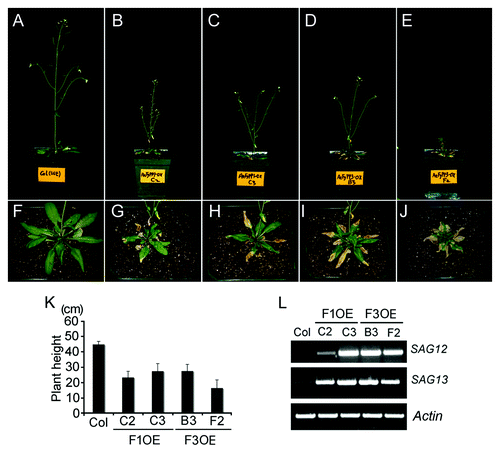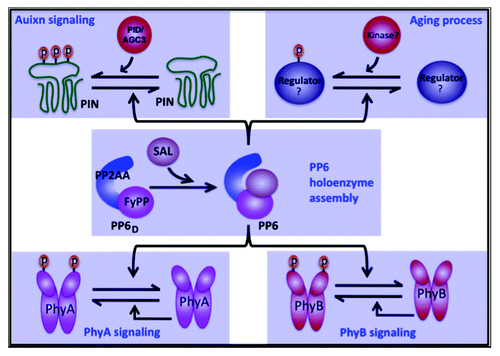Figures & data
Figure 1. The phenotypes of F1OE and F3OE adult plants at 36-d old stage. F1OE (B, C) and F3OE (D, E) plants are dwarf as compared with Col controls (A). Statistical data of the plant height are shown in (K). Values are means ± SD (standard deviations), n = 20. F1OE (G, H) and F3OE (I, J) plants show early senescence as compared with Col controls (F). The senescence-related marker genes, such as SENESCENCE-ASOCIATE GENE 12 (SAG12, AT5G45890) and SAG13 (AT2G29350) were upregulated in F1OE and F3OE leaves (L). The RNA for RT-PCR was extracted from the leaves of 36-d old plants. The primers used in PCR are: SAG12-F 5′- TCATGCAAAAGAGGCACATC-3′, SAG12-R 5′- TATCCATTAAACCGCC TTCG-3′; SAG13-F 5′-CAACAATGTGGGAACGTCAA-3′, SAG13-R 5′- GCGGTGAGA CTTCATTTGCT-3′; Actin-F 5′-CACAATGTTTGGCGGGATTGGTGA-3′, Actin-R 5′-TGTACTTCCTTTCCGGTGGAGCAA-3′. The reverse transcription was performed as described.Citation23

Figure 2. A model showing that PP6 functions as a molecular hub mediating multiple signaling pathways in plants. PP2AA and FyPP proteins interact together to form the PP6 phosphatase dimmer (PP6D). An additional regulatory subunit, SAL, interacts with PP6D to form the PP6 heterotrimeric holoenzyme. In auxin signaling, PP6 directly dephosphorylates the phosphorylated PIN proteins, while PID/AGC3 kinases are responsible to phosphorylate PIN. PP6 phosphatase and PID/AGC3 kinase thus keep the PINs’ phosphorylation homeostasis to direct auxin transport. In light signaling, PP6 directly targets autophosphorylated PhyA and PhyB to regulate light responses. PP6 may also functions antagonistically with unknown kinases to mediate the phosphorylation of some regulators in plant aging process. Question marks indicate unknown factors. p, phosphate.
